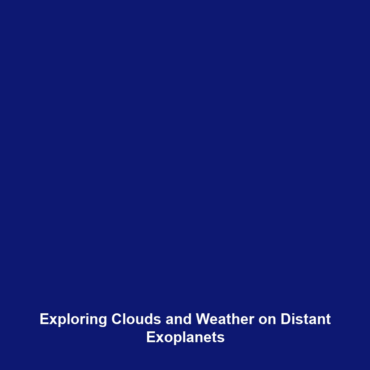Clouds and Weather on Exoplanets: The Discovery of Clouds and Weather Systems on Distant Worlds
Introduction
Understanding clouds and weather systems on exoplanets is a groundbreaking area of research that expands our comprehension of these distant worlds. As astronomers detect more exoplanets within the habitable zone, discovering the atmospheric phenomena, such as clouds and weather, becomes crucial. These findings can provide insights into the potential habitability of these planets and elucidate the complex interactions between their surfaces and atmospheres. The significance of clouds and weather on exoplanets directly influences our search for extraterrestrial life and helps refine climate models on Earth.
Key Concepts
Understanding Exoplanets and Their Atmospheres
Exoplanets, or planets outside our solar system, come in a variety of forms, including gas giants and rocky planets. The study of clouds and weather on these planets fits into broader research within exoplanetary science. Meteorological phenomena, such as cloud formation and various weather systems, can reveal much about a planet’s atmosphere. Factors affecting these systems include:
- Temperature variations: Influenced by a star’s heat and a planet’s distance.
- Atmospheric composition: Different gases interact differently under solar radiation.
- Pressure systems: Similar to Earth’s weather systems, pressure variations can lead to clouds and storms.
Applications and Real-World Uses
The discovery of clouds and weather systems on exoplanets has significant implications for various fields. Key applications include:
- Characterizing habitable zones: Understanding weather patterns is vital for identifying planets where life could exist.
- Astronomical models: Enhancing models that predict exoplanet atmospheres can improve our understanding of Earth’s weather systems.
- Future exploration strategies: Insight into cloud formation can inform missions aimed at studying exoplanetary atmospheres in detail.
Current Challenges
Despite these advances, several challenges persist in studying clouds and weather on exoplanets:
- Data limitations: The vast distances make direct observation of weather systems difficult.
- Instrumental constraints: Existing telescopes may lack the sensitivity required to analyze atmospheric conditions in detail.
- Theoretical models: Current atmospheric models may not accurately predict complex weather phenomena unique to alien environments.
Future Research and Innovations
Research into exoplanetary clouds and weather continues to evolve, with several upcoming innovations anticipated:
- Advanced telescopes: Next-gen technologies, such as the James Webb Space Telescope, will enhance our observational capabilities.
- In-depth simulations: Improved models could allow for more accurate predictions of weather patterns on distant worlds.
- Collaboration across disciplines: Integrating expertise from meteorology and planetary science will drive deeper insights into exoplanetary atmospheres.
Conclusion
In conclusion, the discovery of clouds and weather systems on exoplanets sheds light on these distant worlds and their potential for supporting life. As research and technology advance, our understanding of these systems will deepen, enriching both exoplanetary science and our knowledge of planetary atmospheres in general. To explore further, consider reading about the atmospheric studies on exoplanets or the latest developments in space exploration.

